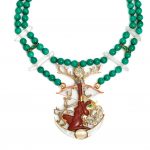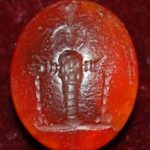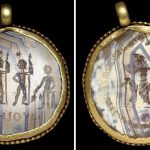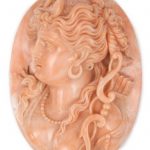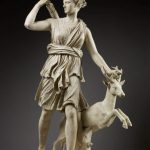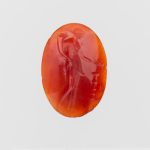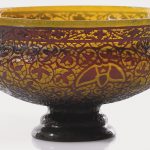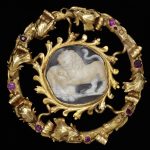Artemis Greek Goddess. Artemis was one of the most widely venerated of the Ancient Greek deities. Her Roman equivalent is Diana. Some scholars believe that the name, and indeed the goddess herself, was originally pre-Greek. Homer refers to her as Artemis Agrotera, Potnia Theron: “Artemis of the wildland, Mistress of Animals”. The Arcadians believed she was the daughter of Demeter.
In the classical period of Greek mythology, Artemis was often described as the daughter of Zeus and Leto, and the twin sister of Apollo. She was the Hellenic goddess of the hunt, wild animals, wilderness, childbirth, virginity and protector of young girls, bringing and relieving disease in women; she often was depicted as a huntress carrying a bow and arrows. The deer and the cypress were sacred to her. In later Hellenistic times, she even assumed the ancient role of Eileithyia in aiding childbirth. Reference: Wikipedia
A cinnabar, hardstone, gem-set and diamond Artemis pendant/necklace, Heyoka depicting Artemis, kneeling within a crescent-moon, shooting an arrow into the sky; composed of moonstone, mother-of-pearl, emerald, malachite and rock crystal; signed Heyoka; old European-cut diamond measuring approximately: 7.0 x 6.7mm; mounted in copper, silver and eighteen karat gold; length: 1in. (clasp in metal)
Sold for US$ 1,750 (£ 1,321) inc. premium at Bonhams in 2013
Cornelian intaglio with a convex front: Artemis of Ephesus.
Reference: © The Trustees of the British Museum
A ROMAN GOLD AND BANDED AGATE MAGICAL PENDANT CIRCA 3RD-4TH CENTURY A.D. The outer edge of the bezel with a fringe of beaded wire, a large suspension loop above, one side of the flat circular stone engraved with four gods, the Castores in the center, each depicted nude, holding a spear, a star above his head, with Apollo to the right standing beside a spiral-fluted column, holding a laurel branch, and Artemis to the left holding her bow and an arrow, inscribed above Aio, perhaps a misspelling of the magical name iao, and inscribed below AEHIOUW, a vowel series used as a magical incantation to indicate the seven planets, the other side with Minerva wearing a tunic and himation, armed with a spear and a crested helmet, holding an olive branch, a ram standing beside her, on a groundline, enclosed within the serpent Ouroboros 2 in. (5 cm.) long
Sold for at Christie’s in 2006
A fine and large ovular pink coral cameo carved in high relief to depict the mythological Roman goddess Diana (known in Greek mythology as Artemis), goddess of the hunt, the moon, and childbirth, the figure presented at bust length in profile with her finely articulated wavy hair tied to crown of head, a string of beads or pearls to her throat, and her bow and quiver of arrows to her front shoulder over a slightly exposed plump bosom. Approximately 2.5″ tall x 1.875″ wide x 0.75″ deep. (64mm x 47mm x 20mm). Total weight approximately 66 grams.
Sold for $500 at Ahlers & Ogletree Auction Gallery in 2015
This work was a gift from Pope Paul IV to the French king Henri II, and one of the first ancient statues to arrive in France. The goddess – Diana to the Romans, Artemis to the Greeks -was Apollo’s twin sister. The goddess of chastity, and a tireless hunter whose arrows could punish the misdeeds of men, she is depicted here accompanied by a deer. The statue is based on a fourth-century BC Greek bronze attributed to Leochares.
Artemis, the Greek goddess of hunting and twin sister to Apollo, is shown here in action, with her tunic (the chiton) tucked up to her knees to make it easier to pursue her quarry. A cape (the himation) passing over her left shoulder, clings closely to her form. The rhythmic, Classical yet naturalistic draperies, and the goddess’s rather aloof majesty, allow us to date the original statue – now lost – to the second Classical period of the fourth century BC.
Reference:The Louvre
Sard cameo of Artemis holding a cornucopia and phiale
Reference: The Metropolitan Museum of Art
